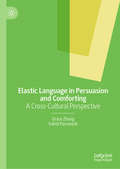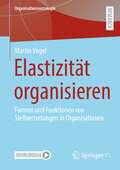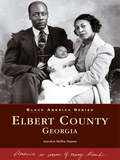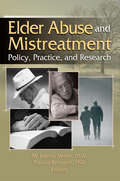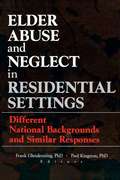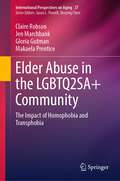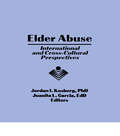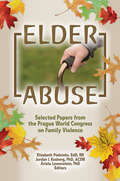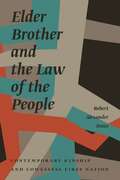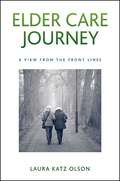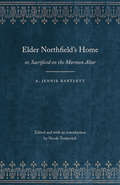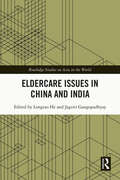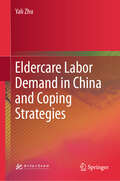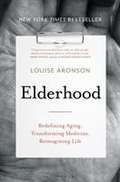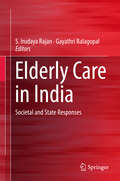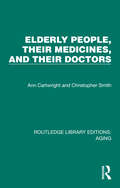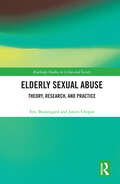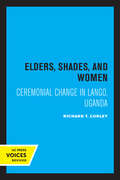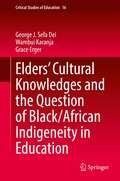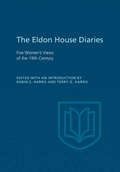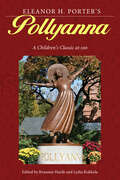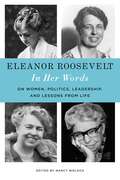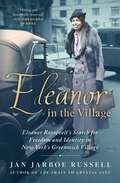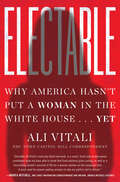- Table View
- List View
Elastic Empire: Refashioning War through Aid in Palestine (Stanford Studies in Middle Eastern and Islamic Societies and Cultures)
by Lisa BhungaliaThe United States integrated counterterrorism mandates into its aid flows in the West Bank and Gaza Strip during the early years of the global war on terror. Some two decades later, this securitized model of aid has become normalized across donor intervention in Palestine. Elastic Empire traces how foreign aid, on which much of the Palestinian population is dependent, has multiplied the sites and means through which Palestinian life is regulated, surveilled, and policed—this book tells the story of how aid has also become war. Drawing on extensive research conducted in Palestine, Elastic Empire offers a novel accounting of the US security state. The US war chronicled here is not one of tanks, grenades, and guns, but a quieter one waged through the interlacing of aid and law. It emerges in the infrastructures of daily life—in a greenhouse and library, in the collection of personal information and mapping of land plots, in the halls of municipal councils and in local elections—and indelibly transfigures lives. Situated in a landscape where the lines between humanitarianism and the global war on terror are increasingly blurred, Elastic Empire reveals the shape-shifting nature of contemporary imperial formations, their realignments and reformulations, their haunted sites, and their obscured but intimate forms.
Elastic Language in Persuasion and Comforting: A Cross-Cultural Perspective
by Grace Zhang Vahid ParvareshThis innovative book examines the discourse of reality television, and the elasticity of language in the popular talent show The Voice from a cross-cultural perspective. Analysing how and why elastic language is used in persuasion and comforting, a comparison between Chinese and English is made, and the authors highlight the special role that elastic language plays in effective interactions and strategic communication. Through the lens of the language variance of two of the world’s most commonly spoken languages, the insights and resources provided by this book are expected to advance knowledge in the fields of contrastive pragmatics and cross-cultural communication, and inform strategies in bridging different cultures. This study highlights the need to give the elastic use of language the attention it deserves, and reveals how language is non-discrete and strategically stretchable. This book will be of interest to academics and postgraduate students engaged in elastic/vague language studies, cross-cultural pragmatics, media linguistics, discourse analysis, sociolinguistics and communication studies.
Elastizität organisieren: Formen und Funktionen von Stellvertretungen in Organisationen (Organisationssoziologie)
by Martin VogelWozu Stellvertretung in Organisationen? – diese Frage ist trivial: Schließlich ist jede/r einmal krank oder im Urlaub. Wenn dann niemand einspringen kann, kann das weitreichende Folgen haben. Wozu also noch diese Studie? – Weil die Frage trivial ist bzw. weil es interessant ist zu beobachten, wie es (in) einem gegebenen Kontext gelingt, ein Phänomen so erscheinen zu lassen, als sei es trivial. Dieser Band leistet einerseits einen Beitrag zum Verständnis von Stellvertretung in Organisationen: die Klärung des Begriffs, die Einordnung von Stellvertretung als organisationale Struktur und die Ermittlung ihrer Funktionen. Zum anderen unterstützt Martin Vogel die Forderung, systemtheoretische Forschung „empiriefähiger“ zu machen und stellt hierfür eine Forschungsheuristik zur Diskussion. Der Titel „Elastizität organisieren“ rückt ein Konzept Niklas Luhmanns ins Zentrum. Mit Hilfe ihrer Stellen können Organisationen auf sich ändernde Umweltbedingungen reagieren, indem sie Stellen neu schaffen, umwidmen, einsparen oder von Beginn an „ambivalent“ programmieren. Das Buch stellt Stellvertretungen als Beispiel dieser „Ambivalenzstrategie“ vor: Auf der Rückseite ihrer trivialen Funktion dienen sie als voraussetzungsvolle „elastische“ Lösung für vielfältige organisationale Probleme.Elastizität zu organisieren ist kein triviales Geschäft.
Elbert County, Georgia (Black America Series)
by Aurolyn Melba HammElbert County, the granite capital of the world, is nestled in the northeast corner of Georgia, in the foothills of the Appalachian Mountains. The educational and political journey of many African Americans in this county began at Elbert Colored High School. African Americans in Elbert County helped shape their community and their country through sheer determination and faith, in the face of slavery and laws biased against them.
Elder Abuse and Mistreatment
by Patricia Brownell Joanna MellorProvide the most effective service possible to help victims of this growing social problemElder Abuse and Mistreatment is a comprehensive overview of current policy issues, new practice models, and up-to-date research on elder abuse and neglect. Experts in the field provide insight into elder abuse with newly examined populations to create an understanding of how to design service plans for victims of abuse and family mistreatment. The book addresses all forms of abuse and neglect, examining the value issues and ethical dilemmas that social workers face in providing service to elderly abuse victims and their families.Elder abuse and neglect is a social problem of increasing concern to policymakers, practitioners, and researchers in the United States and around the world. Elder Abuse and Mistreatment incorporates health, mental health, and social service perspectives that assist social work and health care professionals with interdisciplinary teamwork. The book examines the Elder Justice Act, the Madrid 2002 International Plan of Action on Ageing, new and emerging practice modalities and international models such as shelter programs and support groups, and the latest research on practice methods, elder abuse with special populations, and interventions with victim-abuse dyads. Topics examined in Elder Abuse and Mistreatment include: abuse reporting statutes the roles of agencies involved in abuse investigations service commonly needed by victims funding sources common impediments to service delivery adult protective services (APS) local, state, and federal policies social and economic inclusion self-determination long-term care and nursing homes consumer fraud and financial abuse dependency and compliance and much moreElder Abuse and Mistreatment: Policy, Practice, and Research is an essential resource for educators and students of social work, nursing, and public health, and for social work practitioners.
Elder Abuse and Neglect in Residential Settings: Different National Backgrounds and Similar Responses
by Frank Glendennina Paul KingstonElder Abuse and Neglect in Residential Settings: Different National Backgrounds and Similar Responses contains insights and examples from other countries where elder abuse and neglect have been recognized as an issue requiring social policy attention. Nursing home employees as well as professionals and policymakers will explore the physical as well as the psychological aspects of neglect in nursing homes. Elder Abuse and Neglect in Residential Settings discusses deliberate physical abuse and more common forms of neglect and abuse, such as bedsores, poor nutrition, improper medication, and vermin infestation. Let this informative guide help you recognize the causes of elder abuse and neglect in order to prevent the same problems in your nursing home.Examining nursing home settings in America, Canada, England, Sweden, the United Kingdom, and South Africa to bring you firsthand accounts of the problems of elder abuse on a multicultural level. It also examines reasons for abuse and neglect, such as poor wages, long hours, low job prestige of nurses aides, and high exhaustion levels that have led to abuse and neglect by even the most caring individual. Through Elder Abuse and Neglect in Residential Settings, you will discover what factors directly correlate to the abuse and neglect of patients by: examining the high turnover rates of the lower-paid nurses aides understanding that well-qualified staff do not choose to work in nursing homes and that often abuse and neglect are committed by nurses aides gaining insight into the risks of physical assault and verbal abuse by patients that nurses aides may endure everyday exploring the psychological aspects of neglect in nursing homes such as, uncleanliness, the lack of attractiveness in the physical environment, inadequate diet, infantilization, and passive neglect, and what can be done to prevent these behaviorsElder Abuse and Neglect in Residential Settings discusses the elements that are significant to the future and quality of residential care. From this book, you will understand the importance of considering the characteristics of the patients and staff as well as the importance of developing gender-integrated and multicultural services. Elder Abuse and Neglect in Residential Settings will prove to be essential in your understanding of the worldwide problem of elder abuse and neglect in residential care and help you alleviate it.
Elder Abuse in the LGBTQ2SA+ Community: The Impact of Homophobia and Transphobia (International Perspectives on Aging #37)
by Gloria Gutman Claire Robson Jen Marchbank Makaela PrenticeThis book describes and analyzes the lived experience of elder abuse from the queer community. It discusses the experiences by transwomen, gay men and lesbians of financial abuse, physical and sexual abuse, homophobic abuse, and neglect within partner relationships, residential care, in home care, and religious organizations. Queer and trans elders have been described as ‘The Silent Generation’, since they have lived through times when their sexual and gender identities were criminalized and pathologized. The book shows that they are far more at risk to suffer abuse and neglect by those they should be able to trust, since they are more likely to have encountered all key risk factors, such as isolation, previous abuse and trauma, and mistrust of the health care system. Their vulnerability has been overlooked and this book addresses that gap. As such, this book provides a great resource to anyone working with elders, including medical professionals, care providers, police, counsellors, and policy makers.
Elder Abuse: International and Cross-Cultural Perspectives
by Jordan I Kosberg Juanita L GarciaHere is an informative overview of the causes and consequences of elder abuse in countries around the world. This book delves into the global problem of elder abuse and identifies similarities and differences that occur from country to country. Elder Abuse: International and Cross-Cultural Perspectives increases understanding of the problem of elder abuse, helping you recognize more easily the causes of elder abuse in your own country and find tactics to counter these causes. Strategies from around the world can help in the development of local community resources and social policies to minimize the occurrence of elder abuse and its impact on the elderly, their families, and all members of society.Elder Abuse: International and Cross-Cultural Perspectives discusses elder abuse in countries ranging from Australia to Finland, from South Africa to Hong Kong, from Ireland to Israel. It addresses the consequences of aging, dynamics of elder abuse, family care of the elderly, formal and informal mechanisms for preventing elder abuse, and methods by which to publicize possibilities of abuse. In each chapter, authors explore: the definition of elder abuse in their country the extent of the problem causes of the problem (as related to values and practices) societal attitudes regarding the existence of the problem private and public efforts to detect and prevent the problem and to intervene where it has occurredElder Abuse: International and Cross-Cultural Perspectives provides the impetus for community resources, social planning, and public resources. It is of interest to individuals who work in social work, nursing, and psychology settings and to those in social science fields of sociology, anthropology, and gerontology. The book can also serve as an enlightening reader for undergraduate and graduate/professional education.
Elder Abuse: Selected Papers from the Prague World Congress on Family Violence
by Elizabeth Podnieks Ariela Lowenstein Jordan I KosbergGet up-to-date information and research on elder abuse-from international authorities!Elder Abuse: Selected Papers from the Prague World Congress on Family Violence is an invaluable collection of the most important presentation papers from the Prague World Congress on Family Violence. This comprehensive book presents the latest research and detailed information on the difficult issues surrounding elder abuse around the world. International experts use a multidisciplinary approach to provide ideas and insights to help provide researchers, educators, and practitioners with practical strategies for dealing with the numerous facets of this disturbing issue. Different types of abuse are explored in detail, including physical, financial, and emotional. This comprehensive source is richly referenced, with helpful tables to clearly explain data valuable to all law and health professionals involved in the issues of elder abuse.Elder Abuse: Selected Papers from the Prague World Congress on Family Violence discusses: grandparents raising grandchildren the elder abuse of custodial grandparents combating financial abuse of elders by others a study of elder abuse within diverse cultures forensic medical examination form for improved documentation and prosecution of elder abuse elder abuse in faith communities older women, domestic violence, and elder abuse elder abuse risk indicators elder abuse multidisciplinary teamsElder Abuse: Selected Papers from the Prague World Congress on Family Violence is essential reading for researchers, educators, practitioners, and policymakers in the fields of aging, health, mental health, social services, adult protective services, domestic violence, law, and criminal justice.
Elder Brother and the Law of the People: Contemporary Kinship and Cowessess First Nation
by Robert Alexander InnesIn the pre-reserve era, Aboriginal bands in the northern plains were relatively small multicultural communities that actively maintained fluid and inclusive membership through traditional kinship practices. These practices were governed by the Law of the People as described in the traditional stories of Wîsashkêcâhk, or Elder Brother, that outlined social interaction, marriage, adoption, and kinship roles and responsibilities.In Elder Brother and the Law of the People, Robert Innes offers a detailed analysis of the role of Elder Brother stories in historical and contemporary kinship practices in Cowessess First Nation, located in southeastern Saskatchewan. He reveals how these tradition-inspired practices act to undermine legal and scholarly definitions of “Indian” and counter the perception that First Nations people have internalized such classifications. He presents Cowessess’s successful negotiation of the 1996 Treaty Land Agreement and their high inclusion rate of new “Bill-C31s” as evidence of the persistence of historical kinship values and their continuing role as the central unifying factor for band membership.Elder Brother and the Law of the People presents an entirely new way of viewing Aboriginal cultural identity on the northern plains.
Elder Care Journey: A View from the Front Lines (Excelsior Editions)
by Laura Katz OlsonWinner of a Gold Medal, 2017 Living Now Book Award in the Caregiving categoryShortlisted for the 2016 Sarton Women's Book Awards in the Memoir category presented by the Story Circle NetworkFor millions of Americans caregiving is the "new normal." For Laura Katz Olson, a respected researcher of long-term care for the aging, Elder Care Journey chronicles the disruption of her world and how it is upended by the ever-increasing long-distance needs of her own mother.A healthy, Senior Olympics medal winner, Olson's mother is slowly and steadily incapacitated by Parkinson's disease and a gradual loss of vision. Thrust into a long-distance caregiving role, Olson finds her previous academic notions about assisting a frail parent increasingly at odds with the reality of the lived experience. In a narrative full of "ah-ha!" moments, tears, sighs, and outrage that will be familiar to many, Olson opens a window into the nursing home and home care industries that consume much in the way of taxpayer dollars, but often fail to deliver quality care. Olson's personal story vividly demonstrates not only the overwhelming bureaucratic barriers faced by care-dependent seniors but also their beleaguered adult children's attempts to ensure their parents' health, safety, and well-being.
Elder Northfield's Home: or, Sacrificed on the Mormon Altar (Legacies of Nineteenth-Century American Women Writers)
by A. Jennie Bartlett Nicole TonkovichThe practice of plural marriage, commonly known as polygamy, stirred intense controversy in postbellum America until 1890, when the Church of Jesus Christ of Latter-day Saints first officially abolished the practice. Elder Northfield’s Home, published by A. Jennie Bartlett in 1882, is both a staunchly antipolygamy novel and a call for the sentimental repatriation of polygamy’s victims. Her book traces the fate of a virtuous and educated English immigrant woman, Marion Wescott, who marries a Mormon elder, Henry Northfield. Shocked when her husband violates his promise not to take a second wife, Marion attempts to flee during the night, toddler son in her arms and pulling her worldly possessions in his toy wagon. She returns to her husband, however, and the balance of the novel traces the effects of polygamy on Marion, Henry, and their children; their eventual rejection of plural marriage; and their return to a normal and healthy family structure. Nicole Tonkovich’s critical introduction includes both historical contextualization and comments on selected primary documents, providing a broader look at the general public’s reception of the practice of polygamy in the nineteenth century.
Eldercare Issues in China and India (Routledge Studies on Asia in the World)
by Longtao HeThe contributors to this book present case studies of elder care in China and India, and draw comparisons between the two – illuminating some of the key issues facing the two largest Asian countries as they develop rapidly. Caring for the elderly is a major challenge for all countries, and one which is of acute concern for rapidly developing economies. Development tends to run counter to long-established cultural norms of family-based caring and filial piety, even as it also tends to lead to longer life expectancy. Taking a range of methodological and conceptual approaches to understanding these challenges, the contributors present a multifaceted understanding of elder care issues in both India and China. They focus in particular on caregiving within families and at care homes – and the impacts these have on quality of life and the experience of caregiving for both caregivers and the aged themselves. An invaluable collection for scholars and students of gerontology and aging in Asia, that will also be of great interest to scholars with a broader interest in global trends in caregiving.
Eldercare Labor Demand in China and Coping Strategies
by Yali ZhuThis book employs Markov models and propensity score matching methods to analyze the demand for elderly care labor, utilizing data from the China Longitudinal Healthy Longevity Survey (CLHLS) and World Population Prospects 2022 (United Nations, 2022). The model predicts the health transferring scenario among the aging population firstly, and then the demand for elderly care labor from 2022 to 2058 under a fixed care time demand scenario according to 8-hour working system, as well as national and provincial regulations on caregiver-carereceiver ratios. The accelerated aging process and rapid increase in the younger elderly population will result in a rapid increase in the demand for elderly care labor for the healthy elderly until about 2042, with a 1.5-fold increase. This is followed by accelerated growth in the demand for elderly care labor for the impaired and dysfunctional aging population. Over time, the supply of older adults without care will gradually increase, nearly doubling by 2058 compared to 2022. It is recommended that on the one hand, eldercare labor demand in China can be reduced from the origin by improving the health of the population; and on the other hand, the effective supply of elderly care be expanded by building a modern care service system, improving relevant policies, integrating care resources, and innovating the supply model.
Elderhood: Redefining Aging, Transforming Medicine, Reimagining Life
by Louise Aronson<p>As revelatory as Atul Gawande's Being Mortal, physician and award-winning author Louise Aronson's Elderhood is an essential, empathetic look at a vital but often disparaged stage of life. <p>For more than 5,000 years, "old" has been defined as beginning between the ages of 60 and 70. That means most people alive today will spend more years in elderhood than in childhood, and many will be elders for 40 years or more. Yet at the very moment that humans are living longer than ever before, we've made old age into a disease, a condition to be dreaded, denigrated, neglected, and denied. <p>Reminiscent of Oliver Sacks, noted Harvard-trained geriatrician Louise Aronson uses stories from her quarter century of caring for patients, and draws from history, science, literature, popular culture, and her own life to weave a vision of old age that's neither nightmare nor utopian fantasy--a vision full of joy, wonder, frustration, outrage, and hope about aging, medicine, and humanity itself. <p>Elderhood is for anyone who is, in the author's own words, "an aging, i.e., still-breathing human being."</p>
Elderly Care in India
by S. Irudaya Rajan Gayathri BalagopalThis volume highlights a range of issues underpinning elder care in India, with particular focus on the challenges that India faces in caring for the elderly. In addition to the very limited state support and near total dependence on the family for long-term social care and economic support, the changing dynamics between generations in the family structure and privatization of health care in general create new challenges that need to be addressed. Although care plays a significant role in the well-being of the elderly, there is not much research available from India. This volume draws on field-based evidence and the legal framework in India to understand the ways in which care is organized for the elderly and to locate the main sources of care provision. The book addresses key themes such as shrinking of traditional support base of the elderly, trajectory of old age homes in India and care arrangements for the elderly within the community. Written by academics and practitioners in the field of gerontology, this book is an informative resource for demographers, gerontologists, social scientists studying aging, and human rights and legal experts working with the aged.
Elderly People, Their Medicines, and Their Doctors (Routledge Library Editions: Aging)
by Christopher Smith Ann CartwrightIn the late 1980s, an increasing proportion of all prescribed medicines went to people over 65 years of age, not only because they constituted a growing sector of the population but also because their consumption rate, unlike that of younger people was increasing. This increase was therefore a matter for widespread concern which had until now been largely speculative, as no recent national survey had focused on this issue.Originally published in 1988, Ann Cartwright and Christopher Smith looked at the medicines prescribed for, and taken by, a nationally representative sample of elderly people. The experiences and views of both patients (elderly people) and professionals (general practitioners) are examined and related. What is revealed is how much, and how little GPs knew about the social circumstances and medicine taking of their elderly patients. Evaluation of all the prescribed medicines taken shows the extent of elderly people’s knowledge of their medication and identifies duplications, potentially harmful interactions, contraindications, and inappropriate dosages. Recommendations for action to be taken by doctors, pharmacists, medical educators, and elderly people themselves made this book essential reading for all those concerned with the health and welfare of elderly people at the time.
Elderly Sexual Abuse: Theory, Research, and Practice (Routledge Studies in Crime and Society)
by Eric Beauregard Julien ChopinThis book offers an analytical review of the state of knowledge on elderly sexual abuse and presents new data that will confront some of the accepted ideas and some of the myths associated with this specific form of sexual violence. Sexual violence research has often considered children to be the most vulnerable population. However, another population just as vulnerable to sexual abuse but often overlooked by researchers, is the elderly. Evidence shows that elderly victims are more likely to be attacked by strangers, most likely to be victimized in their own homes, and are usually less capable of resisting a physical attack. Drawing on a large and representative dataset, Elderly Sexual Abuse offers a full and theoretically informed picture of the offenders and their crimes. In addition to a specific chapter devoted to prevention and criminal investigation, the book also connects research to practice, exploring what the findings mean for professionals working with these cases and the criminal justice system. This book is essential reading for all those engaged with sexual violence, victimization, elder abuse, and vulnerable populations.
Elders, Shades, and Women: Ceremonial Change in Lango, Uganda
by Richard T. CurleyIn Elders, Shades, and Women, Richard T. Curley describes the ceremonial life of a Nilotic community in northern Uganda and traces the alterations in its ceremonial activities from the turn of the twentieth century to the beginning of extensive contact between the Langi and Europeans in the 1960s. Setting his analysis within the broad context of Lango social organization, Curley discusses the makeup of the community and shows how the innovations of the colonial period led to changes in kinship relations and residential patterns. He is particularly attentive to the husband-wife relationship and to the changing status of women within a patrilineal system. After describing Lango social organization and the changes that it has undergone, Curley turns to the three complexes of Lango ceremonial activity. One of these, traditionally performed by older men, has virtually disappeared, a victim of altered political relationships. The second set, comprising eight separate ceremonies performed for married women, concerns the problem of incorporating a women into her husband's lineage while recognizing that she was born in her father's. The third complex, centering on spirit possession, has become increasingly popular, and women participate to a much greater extent than men. The author treats his religious material within the framework of structural-functionalism by concentrating on ceremonial activities rather than on belief and by relating the ceremonies to social processes. He departs from structural-functionalism, however, in borrowing heavily from work on the analysis of symbols, and he attempts to describe change rather than analyzing Lango religious activity at a single point in time. This title is part of UC Press's Voices Revived program, which commemorates University of California Press’s mission to seek out and cultivate the brightest minds and give them voice, reach, and impact. Drawing on a backlist dating to 1893, Voices Revived makes high-quality, peer-reviewed scholarship accessible once again using print-on-demand technology. This title was originally published in 1973.
Elders’ Cultural Knowledges and the Question of Black/ African Indigeneity in Education (Critical Studies of Education #16)
by George J. Dei Wambui Karanja Grace ErgerThis book makes a strong case for the inclusion of Indigenous Elders’ cultural knowledge in the delivery of inclusive education for learners who are members of minority communities. It is relevant to curriculum developers, teachers, policy makers and institutions that engage in the education of Black, Indigenous, Latinx and other minority students. This book provides opportunities for exploring the decolonization of educational approaches. It promotes the synthesis of multiple types of knowledge and ways of knowing by making a case for the incorporation of Indigenous knowledges and Indigenous Elders as teachers in learning spaces. The book is of interest to educators, students, and researchers of Indigenous knowledge and decolonizing education. Additionally, it is important for educational policy makers, especially those engaged in looking for strategic solutions to bridging educational disparities and gaps for Indigenous, Black, Latinx and other minority learners.
Eldon House Diaries: Five Women's Views of the 19th Century
by Robin Harris Terry HarrisEldon House is a distinctive element in the historical townscape of London, Ontario. By the mid-nineteenth century, its original owners, John and Amelia Harris, were prominent members of society in that dynamic community. Their children grew up in the affluent and cultured setting of a family whose increasing prosperity advanced with that of London and western Ontario. If London had an elite, the Harris family was part of it, and Eldon House was an important focal point of the social regimen of the day. A considerable corpus of family papers within the Eldon House and prominent among these papers is a collection of diaries that are excerpted in this volume, encapsulating the personalities, activities, and voices of the Harrises of London. These diaries are valuable because of the details of the warp and woof of daily life in the nineteenth century. But, more importantly, they are women's diaries. As such, they speak to us of the verities of personal, domestic, and societal life in the neglected voice of women. Together, they provide a fascinating perspective of these women's lives in, around, and beyond Eldon House.
Eleanor H. Porter's Pollyanna: A Children's Classic at 100 (Children's Literature Association Series)
by Roxanne Harde and Lydia KokkolaAppearing first as a weekly serial in The Christian Herald, Eleanor H. Porter's Pollyanna was first published in book form in 1913. This popular story of an impoverished orphan girl who travels from America's western frontier to live with her wealthy maternal Aunt Polly in the fictional east coast town of Beldingsville went through forty-seven printings in seven years and remains in print today in its original version, as well as in various translations and adaptations. The story's enduring appeal lies in Pollyanna's sunny personality and in her glad game, her playful attempt to accentuate the positive in every situation. In celebration of its centenary, this collection of thirteen original essays examines a wide variety of the novel's themes and concerns, as well as adaptations in film, manga, and translation. In this edited collection on Pollyanna, internationally respected and emerging scholars of children's literature consider Porter's work from modern critical perspectives. Contributors focus primarily on the novel itself but also examine Porter's sequel, Pollyanna Grows Up, and the various film versions and translations of the novel. With backgrounds in children's literature, cultural and film studies, philosophy, and religious studies, these scholars extend critical thinking about Porter's work beyond the thematic readings that have dominated previous scholarship. In doing so, the authors approach the novel from theoretical perspectives that examine what happens when Pollyanna engages with the world around her—her community and the natural environment—exposing the implicit philosophical, religious, and nationalist ideologies of the era in which Pollyanna was written. The final section is devoted to studies of adaptations of Porter's protagonist.
Eleanor Roosevelt: On Women, Politics, Leadership, and Lessons from Life
by Nancy WolochThis illustrated, first of its kind collection of excerpts from Eleanor Roosevelt's newspaper columns, radio talks, speeches, and correspondence speaks directly to the challenges we face today.Acclaimed for her roles in politics and diplomacy, first lady Eleanor Roosevelt was also a prolific author, journalist, lecturer, broadcaster, educator, and public personality. Using excerpts from her books, columns, articles, press conferences, speeches, radio talks, and correspondence, Eleanor Roosevelt: In Her Words tracks her contributions from the 1920s, when she entered journalism and public life; through the White House years, when she campaigned for racial justice, the labor movement, and "the forgotten woman;" to the postwar era, when she served at the United Nations and shaped the Universal Declaration of Human Rights. Selections touch on Roosevelt's early entries in women's magazines ("Ten Rules for Success in Marriage"), her insights on women in politics ("Women Must Learn to Play the Game As Men Do"), her commentary on World War II ("What We Are Fighting For"), her work for civil rights ("The Four Equalities"), her clash with Soviet delegates at the UN ("These Same Old Stale Charges"), and her advice literature ("If You Ask Me"). Surprises include her unique preparation for leadership, the skill with which she defied critics and grasped authority, her competitive stance as a professional, and the force of her political messages to modern readers. Scorning the "America First" mindset, Eleanor Roosevelt underlined the interdependence of people and of nations. Eleanor Roosevelt: In Her Words illuminates her achievement as a champion of civil rights, human rights, and democratic ideals.
Eleanor in the Village: Eleanor Roosevelt's Search for Freedom and Identity in New York's Greenwich Village
by Jan Jarboe RussellA vivid and incisive account of a mostly unknown yet critical chapter in the life of Eleanor Roosevelt—when she moved to New York&’s Greenwich Village, shed her high-born conformity, and became the progressive leader who pushed for change as America&’s First Lady.Hundreds of books have been written about FDR and Eleanor, both together and separately, but yet she remains a compelling and elusive figure. And, not much is known about why in 1920, Eleanor suddenly abandoned her duties as a mother of five and moved to Greenwich Village, then the symbol of all forms of transgressive freedom—communism, homosexuality, interracial relationships, and subversive political activity. Now, in this fascinating, in-depth portrait, Jan Russell pulls back the curtain on Eleanor&’s life to reveal the motivations and desires that drew her to the Village and how her time there changed her political outlook. A captivating blend of personal history detailing Eleanor&’s struggle with issues of marriage, motherhood, financial independence, and femininity, and a vibrant portrait of one of the most famous neighborhoods in the world, this unique work examines the ways that the sensibility, mood, and various inhabitants of the neighborhood influenced the First Lady&’s perception of herself and shaped her political views over four decades, up to her death in 1962. When Eleanor moved there, the Village was a neighborhood of rogues and outcasts, a zone of Bohemians, misfits, and artists. But there was also freedom there, a miniature society where personal idiosyncrasy could flourish. Eleanor joined the cohort of what then was called &“The New Women&” in Greenwich Village. Unlike the flappers in the 1920s, the New Women had a much more serious agenda, organizing for social change—unions for workers, equal pay, protection for child workers—and they insisted on their own sexual freedom. These women often disagreed about politics—some, like Eleanor, were Democrats, others Republicans, Socialists, and Communists. Even after moving into the White House, Eleanor retained connections to the Village, ultimately purchasing an apartment in Washington Square where she lived during World War II and in the aftermath of Roosevelt&’s death in 1945. Including the major historical moments that served as a backdrop for Eleanor&’s time in the Village, this remarkable work offers new insights into Eleanor&’s transformation—emotionally, politically, and sexually—and provides us with the missing chapter in an extraordinary life.
Electable: Why America Hasn't Put a Woman in the White House . . . Yet
by Ali VitaliA fearless deep dive into the 2020 election from former MSNBC “Road Warrior” and now NBC Capitol Hill correspondent Ali Vitali, who covered the campaign trail every step of the way—investigating the gendered double standards placed on women presidential candidates of that cycle and those who came before, and what it will take for a woman to finally break the glass ceiling and win the White House.Opening with the moment when Joe Biden and Kamala Harris were finally declared the winners of the 2020 race—the long, drawn-out journey towards who would next inhabit the White House, and the resulting and disputed defeat of Donald Trump, Electable is a sweeping look at a lingering question from that Presidential race. Why, when we saw more women run for President of the United States than ever before in our history, did we still not cross that final hurdle? Following the 2020 race minute by minute as the reporter embedded with Elizabeth Warren, Ali Vitali witnessed up-close the way that our most recent election was unique—not simply for the way in which the incumbent conducted himself, but for the ways in which the field, rich with Democrats from all kinds of backgrounds, was both modern but also more of the same. With more female candidates than ever before, this was a history-making race, and yet these women—most of them incredibly qualified with decades of public service on their resumes—dealt once again with a different level of scrutiny than their male counterparts. Woven throughout is close examination of the treatment of Hillary Clinton, Geraldine Ferraro, Shirley Chisholm, and those on the right as well. Grappling with ideas around the “likeability” and “electability” issues, as well as fundraising hurdles many female candidates face, Vitali asks the same questions she and so many have been grappling with for decades, but especially since Hillary Clinton’s devastating defeat in 2016: Why is it so hard for a woman to be taken seriously as a presidential contender? What will it take for men and women to be held to the same standard? What happens next?Electable tackles these questions, with specific, behind-the-scenes, play-by-play detail.Gabbard, Harris, Williamson, Gillibrand, Warren, Klobuchar…and then there were none.

